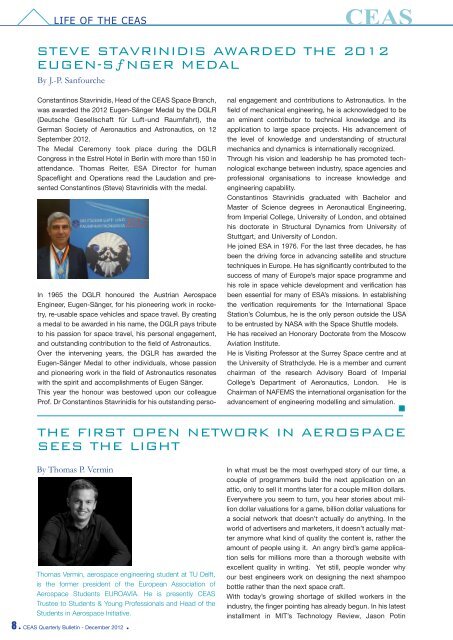Iam - CEAS. Council of European Aerospace Societies
Iam - CEAS. Council of European Aerospace Societies
Iam - CEAS. Council of European Aerospace Societies
Create successful ePaper yourself
Turn your PDF publications into a flip-book with our unique Google optimized e-Paper software.
LIFE OF THE <strong>CEAS</strong><br />
STEVE STAVRINIDIS AWARDED THE 2012<br />
EUGEN-SƒNGER MEDAL<br />
By J.-P. Sanfourche<br />
Constantinos Stavrinidis, Head <strong>of</strong> the <strong>CEAS</strong> Space Branch,<br />
was awarded the 2012 Eugen-Sänger Medal by the DGLR<br />
(Deutsche Gesellschaft für Luft-und Raumfahrt), the<br />
German Society <strong>of</strong> Aeronautics and Astronautics, on 12<br />
September 2012.<br />
The Medal Ceremony took place during the DGLR<br />
Congress in the Estrel Hotel in Berlin with more than 150 in<br />
attendance. Thomas Reiter, ESA Director for human<br />
Spaceflight and Operations read the Laudation and presented<br />
Constantinos (Steve) Stavrinidis with the medal.<br />
In 1965 the DGLR honoured the Austrian <strong>Aerospace</strong><br />
Engineer, Eugen-Sänger, for his pioneering work in rocketry,<br />
re-usable space vehicles and space travel. By creating<br />
a medal to be awarded in his name, the DGLR pays tribute<br />
to his passion for space travel, his personal engagement,<br />
and outstanding contribution to the field <strong>of</strong> Astronautics.<br />
Over the intervening years, the DGLR has awarded the<br />
Eugen-Sänger Medal to other individuals, whose passion<br />
and pioneering work in the field <strong>of</strong> Astronautics resonates<br />
with the spirit and accomplishments <strong>of</strong> Eugen Sänger.<br />
This year the honour was bestowed upon our colleague<br />
Pr<strong>of</strong>. Dr Constantinos Stavrinidis for his outstanding perso-<br />
8 • <strong>CEAS</strong> Quarterly Bulletin - December 2012 •<br />
nal engagement and contributions to Astronautics. In the<br />
field <strong>of</strong> mechanical engineering, he is acknowledged to be<br />
an eminent contributor to technical knowledge and its<br />
application to large space projects. His advancement <strong>of</strong><br />
the level <strong>of</strong> knowledge and understanding <strong>of</strong> structural<br />
mechanics and dynamics is internationally recognized.<br />
Through his vision and leadership he has promoted technological<br />
exchange between industry, space agencies and<br />
pr<strong>of</strong>essional organisations to increase knowledge and<br />
engineering capability.<br />
Constantinos Stavrinidis graduated with Bachelor and<br />
Master <strong>of</strong> Science degrees in Aeronautical Engineering,<br />
from Imperial College, University <strong>of</strong> London, and obtained<br />
his doctorate in Structural Dynamics from University <strong>of</strong><br />
Stuttgart, and University <strong>of</strong> London.<br />
He joined ESA in 1976. For the last three decades, he has<br />
been the driving force in advancing satellite and structure<br />
techniques in Europe. He has significantly contributed to the<br />
success <strong>of</strong> many <strong>of</strong> Europe’s major space programme and<br />
his role in space vehicle development and verification has<br />
been essential for many <strong>of</strong> ESA’s missions. In establishing<br />
the verification requirements for the International Space<br />
Station’s Columbus, he is the only person outside the USA<br />
to be entrusted by NASA with the Space Shuttle models.<br />
He has received an Honorary Doctorate from the Moscow<br />
Aviation Institute.<br />
He is Visiting Pr<strong>of</strong>essor at the Surrey Space centre and at<br />
the University <strong>of</strong> Strathclyde. He is a member and current<br />
chairman <strong>of</strong> the research Advisory Board <strong>of</strong> Imperial<br />
College’s Department <strong>of</strong> Aeronautics, London. He is<br />
Chairman <strong>of</strong> NAFEMS the international organisation for the<br />
advancement <strong>of</strong> engineering modelling and simulation.<br />
THE FIRST OPEN NETWORK IN AEROSPACE<br />
SEES THE LIGHT<br />
By Thomas P. Vermin In what must be the most overhyped story <strong>of</strong> our time, a<br />
couple <strong>of</strong> programmers build the next application on an<br />
attic, only to sell it months later for a couple million dollars.<br />
Everywhere you seem to turn, you hear stories about million<br />
dollar valuations for a game, billion dollar valuations for<br />
a social network that doesn’t actually do anything. In the<br />
world <strong>of</strong> advertisers and marketers, it doesn’t actually matter<br />
anymore what kind <strong>of</strong> quality the content is, rather the<br />
amount <strong>of</strong> people using it. An angry bird’s game application<br />
sells for millions more than a thorough website with<br />
Thomas Vermin, aerospace engineering student at TU Delft,<br />
is the former president <strong>of</strong> the <strong>European</strong> Association <strong>of</strong><br />
<strong>Aerospace</strong> Students EUROAVIA. He is presently <strong>CEAS</strong><br />
Trustee to Students & Young Pr<strong>of</strong>essionals and Head <strong>of</strong> the<br />
Students in <strong>Aerospace</strong> Initiative.<br />
excellent quality in writing. Yet still, people wonder why<br />
our best engineers work on designing the next shampoo<br />
bottle rather than the next space craft.<br />
With today’s growing shortage <strong>of</strong> skilled workers in the<br />
industry, the finger pointing has already begun. In his latest<br />
installment in MIT’s Technology Review, Jason Potin



